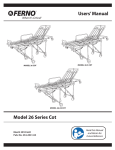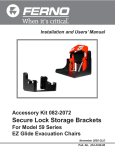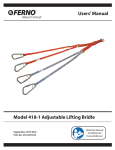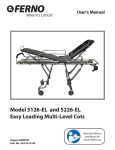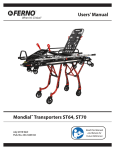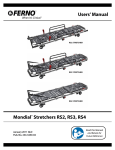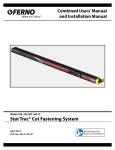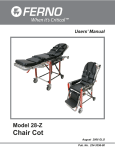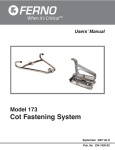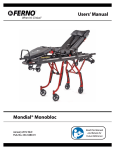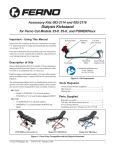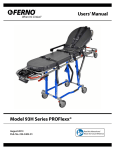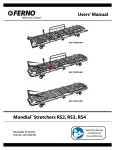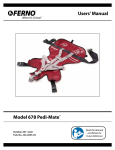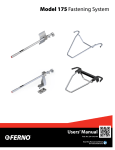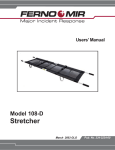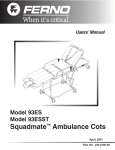Download Ferno 28 Fernoflex Roll-In Chair Cot User Manual
Transcript
FERNO ® When It’s Critical ® Users’ Manual Model 28 Ferno-Flex™ Roll-In Chair Cot September 2009 GLO Pub. No. 234-3288-02 Read this Manual and Retain for Future Reference Model 28 Ferno-Flex™ Ferno Customer Relations For ordering assistance or general information: CANADA AND THE U.S.A. Telephone (Toll-free) Telephone Fax (Toll-free) Fax 1.877.733.0911 1.937.382.1451 1.888.388.1349 1.937.382.1191 Internet www.ferno.com ALL OTHER LOCATIONS For assistance or information, please contact your Ferno distributor. If you do not have a Ferno distributor, please contact Ferno Customer Relations: Ferno-Washington, Inc. 70 Weil Way Telephone Fax Wilmington, Ohio 45177-9371, U.S.A. +1.937.382.1451 +1.937.382.6569 Internet www.ferno.com EUROPEAN REPRESENTATIVE Ferno (UK) Limited Stubs Beck Lane, Cleckheaton West Yorkshire BD19 4TZ, United Kingdom Telephone +44 (0) 1274 851999 Fax +44 (0) 1274 851111 Internet www.ferno.co.uk Ferno Technical Support Customer service and product support are important aspects of each Ferno product. Please have the product serial number available when calling, and include it in all written communications. For technical support questions: Telephone (Toll-free) 1.800.733.3766 ext. 1010 Telephone 1.937.382.1451 ext. 1010 Email [email protected] Disclaimer This manual contains general instructions for the use, operation and care of this product. The instructions are not all-inclusive. Safe and proper use of this product is solely at the discretion of the user. Safety information is included as a service to the user. All other safety measures taken by the user should be within and under consideration of applicable regulations. It is recommended that training on the proper use of this product be provided before using this product in an actual situation. Retain this manual for future reference. Include it with the product in the event of transfer to new users. Additional free copies are available upon request from Customer Relations. Serial Number _________________________ Location: Backrest Mount Crosstube USERS’ MANUALS AND TRAINING DVD 283-1304 To request additional free users’ manuals or training DVDs, contact Ferno Customer Relations, your Ferno distributor, or visit www. ferno.com. Proprietary Notice The information disclosed in this manual is the property of FernoWashington, Inc., Wilmington, Ohio, USA. Ferno-Washington, Inc. reserves all patent rights, proprietary design rights, manufacturing rights, reproduction use rights, and sales use rights thereto, and to any article disclosed therein except to the extent those rights are expressly granted to others or where not applicable to vendor proprietary parts. Limited Warranty Statement The products sold by Ferno are covered by a limited warranty, which is printed on the invoice you received when you purchased the product. Please refer to the warranty terms as printed on your invoice. The complete terms and conditions of the limited warranty, and the limitations of liability and disclaimers, are also available upon request by calling Ferno at 1.800.733.3766 or 1.937.382.1451. © Copyright Ferno-Washington, Inc. All Rights Reserved. 2 © Ferno-Washington, Inc 234-3288-02 September 2009 Model 28 Ferno-Flex™ TABLE OF CONTENTS Section Page Ferno Customer Relations ______________________ 2 Ferno Technical Support _______________________ 2 1 - Safety Information___________________________ 4 1.1 Warning ________________________________ 4 1.2 Important _______________________________ 4 1.3 Bloodborne Disease Notice_________________ 4 1.4 Cot and Fastener Compatibility _____________ 4 1.5 Symbol Glossary _________________________ 4 1.6 Safety and Instruction Label ________________ 5 2 - Operator Skills and Training __________________ 5 2.1 Skills __________________________________ 5 2.2 Training ________________________________ 5 2.3 Height and Strength Considerations __________ 5 3 - About the Cot _______________________________ 6 3.1 Description _____________________________ 6 3.2 Ambulance Requirements __________________ 6 3.3 GeneralSpecifications ____________________ 6 3.4 Components ____________________________ 7 4 - Using the Features ___________________________ 8 4.1 Backrest________________________________ 8 4.2 Cot/Chair Conversion and Adjusting the Chair Position ________________ 8 4.3 Swing-Down Sidearms ____________________ 9 4.4 Undercarriage Safety Lock _________________ 9 4.5 Leg-Lock Clip ___________________________ 9 4.6 Patient Restraints _______________________ 10 4.7 Cot Mattress ___________________________ 10 © Ferno-Washington, Inc 234-3288-02 September 2009 Section Page 5 - Using The Cot______________________________ 11 5.1 Before Placing the Cot in Service ___________ 11 5.2 General Guidelines for Use ________________ 11 5.3 One Operator, Empty Cot _________________ 12 5.4 Folding the Cot With a Patient On It ________ 12 5.5 Unfolding the Cot With a Patient On It ______ 13 5.6 Rolling the Cot or Chair __________________ 13 5.7 Loading the Cot_________________________ 14 5.8 Unloading the Cot _______________________ 14 5.9 Using Additional Help ___________________ 15 6 - Maintenance _______________________________ 16 6.1 Maintenance Schedule ___________________ 16 6.2 Disinfecting and Cleaning the Restraints _____ 16 6.3 Disinfecting and Cleaning the Mattress ______ 16 6.4 Disinfecting the Cot _____________________ 16 6.5 Cleaning the Cot ________________________ 16 6.6 Waxing the Cot _________________________ 17 6.7 Inspecting the Cot _______________________ 17 6.8 Lubricating the Cot ______________________ 17 7 - Parts and Service ___________________________ 18 7.1 U.S.A. and Canada ______________________ 18 7.2 Worldwide _____________________________ 18 7.3 Parts List ______________________________ 18 8 - Accessories and Related Products _____________ 18 Training Record ______________________________ 19 Maintenance Record ___________________________ 19 3 Safety Information Model 28 Ferno-Flex™ 1 - SAFETY INFORMATION 1.1 Warning 1.4 Cot and Fastener Compatibility Warning notices indicate a potentially hazardous situation which, if not avoided, could result in injury or death. Combining different manufacturers’ products into a “mixedcomponent” cot/cot fastener system can increase the user’s risk of injury and damage. WARNING Untrained operators can cause injury or be injured. Permit only trained personnel to operate the cot. Improper use of the cot can cause injury. Use the cot only for the purpose described in this manual. Improper operation can cause injury. Operate the cot only as described in this manual. An unattended patient can be injured. Stay with the patient at all times. Ferno-Washington, Inc. strongly recommends that only Ferno-manufactured cots be used in Ferno-manufactured cot fasteners, and that only Ferno-manufactured cot fasteners be used for securing Ferno-manufactured cots in ambulances. ANY COMBINATION OF A FERNO COT OR COT FASTENER WITH A NON-FERNO COT OR COT FASTENER IS MISUSE OF THE FERNO PRODUCT. Responsibility for the outcome of known, intentional misuse rests squarely on the misuser. An unrestrained patient can fall off the cot and be injured. Use restraints to secure the patient on the cot. Helpers can cause injury or be injured. Maintain control of the cot, operate the controls, and direct all helpers. 1.5 Symbol Glossary Improper maintenance can cause injury. Maintain the cot only as described in this manual. The symbols defined below are used on the cot and in this users’ manual. Ferno uses symbols recognized by the International Standards Organization (ISO), American National Standards Institute (ANSI) and the emergency medical services industry. Improper parts and service can cause injury. Use only Ferno parts and Ferno-approved service on the cot. Modifying the cot can cause injury and damage. Use the cot only as designed by Ferno. 650 lb 295 kg 1.2 Important General Warning of Potential Injury Load Limit Important notices emphasize important usage or maintenance information. Important 2 Read the Users’ Manual Cot Operation Requires Two Trained Operators 1.3 Bloodborne Disease Notice To reduce the risk of exposure to bloodborne diseases such as HIV-1 and hepatitis when using the cot, follow the disinfecting and cleaning instructions in this manual. Do Not Lubricate Lubricate Unlocked Locked Product meets European Union Standards 4 © Ferno-Washington, Inc 234-3288-02 September 2009 Model 28 Ferno-Flex™ Operator Skills and Training 1.6 Safety and Instruction Label Safety and instruction labels place important information from the users’ manual on the cot. Read and follow label instructions. Replace worn or damaged labels immediately. New labels are available from EMSAR (page 18) or from your distributor. The labelbelowisaffixedtothecotmainframeatthefootend. 2 - OPERATOR SKILLS AND TRAINING 2.1 Skills 2.2 Training Operators using the cot need: Operator trainees need to: ● a working knowledge of emergency patient-handling procedures. ● the ability to assist the patient. ● read and understand this manual. ● be trained on the use of the cot. ● practice with the cot before using it with a patient. ● record their training information. A sample training record sheet is provided on page 19. WARNING Untrained operators can cause injury or be injured. Permit only trained personnel to operate the cot. 2.3 Height and Strength Considerations When unloading the cot, the foot-end operator must lift and hold the weight of the cot, patient and equipment high enough for the wheels to remain off the ground until the undercarriage legs completely unfold and lock into place. Be aware that if the ambulance is parked on an uneven surface, the foot-end operator (and any helpers) may need to lift the cot higher than normal to allow the legs to unfold completely and lock. Supporting this weight requires greater strength from short operators than from tall operators because short operators must raise their arms higher in relation to their shoulders. Note: Use additional help as needed to lift the weight of the cot, patient and equipment (see Using Additional Help, page 15). © Ferno-Washington, Inc 234-3288-02 September 2009 5 About the Cot Model 28 Ferno-Flex™ 3 - ABOUT THE COT 3.1 Description The Model 28 Ferno-Flex™ Roll-In Chair Cot (called the cot in this manual) is an emergency patient-handling device designed to transport a patient in a ground-based ambulance. Thecotconvertstoafour-positionchairforuseinconfined spaces and/or for patient comfort. The cot is for professional use by a minimum of two trained operators. Additional help is needed when folding the cot with a patient on it. The cot is designed for roll-in loading to help reduce the risk of back injury to medical service personnel. The cot is designed for use only with a Ferno® Model 173 Cot Fastening System (not included). COT FEATURES ● Eight-position backrest ● Swing-down sidearms ● 5" (13 cm) swivel transport wheels at foot end ● Undercarriage safety lock ● Leg Lock ● Set of restraints ● Attachable Mattress WARNING Improper use of the cot can cause injury. Use the cot only for the purpose described in this manual. 3.3 General Specifications CONFIGURED AS A CHAIR Height Maximum Overall Width Depth 55 in (140 cm) 23 in (58 cm) 45 in (114 cm) CONFIGURED AS A COT Height Bed Position Minimum (folded) Bed Position Maximum Loading Height Overall Width Length Folded Length Unfolded 1 8 in (20 cm) 32 in (81 cm) 26 in (65 cm) 23 in (58 cm) 78 in (198 cm) 75 in (191 cm) OTHER SPECIFICATIONS Weight Load Limit 3 Strength to Weight Ratio (SWR) 2 67 lb (30 kg) 650 lb (295 kg) 9.7 General specifications are rounded to the nearest whole number. Metric conversions are calculated before rounding the Imperial measurements. For more information, contact Ferno Customer Relations (page 2) or your Ferno distributor. 3.2 Ambulance Requirements ● The ambulance bumper extension must not exceed 16 in. (41 cm). ● Thepatientcompartmentmusthavealevelfloorlarge enough for the folded cot. ● A Ferno® Model 173 Cot Fastener is required (not included). Fernoreservestherighttochangespecificationswithoutnotice. Cot Height measurements are as follows: Loading Height is the distance from the ground to the bottom of the loading wheel. Bed Position is the distance from the ground to the patient surface at the center of the cot. 1 Weight is without mattress, restraints. 2 Strength to Weight Ratio is the load limit of the cot divided by the cot’s weight. 3 Load Limit 650 lb 295 kg Load Limit 6 Inspect the cot if the load limit has been exceeded (See Inspecting the Cot, page 17). © Ferno-Washington, Inc 234-3288-02 September 2009 About the Cot Model 28 Ferno-Flex™ 3.4 Components HEAD END Harness Restraint Backrest Sidearm (2) Loading Wheel Crosstube Restraints (2) Mattress Loading Wheel (2) Chair-Adjustment Handle Undercarriage Safety Lock (not visible) FOOT END Undercarriage Control Handle Undercarriage Swivel Wheel (2) USERS’ MANUAL AND TRAINING DVDS To request additional free users’ manuals or training DVDs, contact Ferno Customer Relations, your Ferno distributor, or visit www.ferno.com. © Ferno-Washington, Inc 234-3288-02 September 2009 7 Using the Features Model 28 Ferno-Flex™ 4 - USING THE FEATURES 4.1 Backrest Backrest Adjustment Lever The eight-position backrest allows the operator to elevate the patient’s torso for patient comfort or medical necessity. 1. Unfasten or loosen the torso restraint before adjusting the backrest. 2. Support the backrest frame with one hand and squeeze the adjustment lever with the other hand (Figure 1), then move the backrest to its new position and release the adjustment lever. Continue to support the backrest frame until it locks into the new position. 3. Fasten and adjust the torso restraint. Important Operators should expect, and be prepared to control, the normal downward movement of the backrest that occurs when the control lever is squeezed. 4.2 Cot/Chair Conversion and Adjusting the Chair Position The cot converts to a chair with four positions that range from nearly supine to upright. To convert the cot to a chair, or to change the chair position: 1. Loosen or unfasten the torso restraint. 2. Lower the backrest to the lowest position. 3. Grasp the loading wheel crosstube with one hand and press down on the chair adjustment handle with the other hand (Figure 2). 4. Change the cot or chair position by pulling up or pushing down on the loading wheel crosstube. 5. When the chair is near the desired position, release the chair adjustment handle and move the loading-wheel crosstube up or down a little until the chair adjustment handle locks into place. Figure 1 - Adjusting the Backrest Important The chair position is adjusted independently of the backrest. Before adjusting the chair position, lower the backrest to the flat position in order to prevent leaning the patient's upper body too far forward and causing discomfort. This Hand On Loading Wheel Crosstube Note: Support the weight until the adjustment handle engages and provides the support. 6. Adjust the backrest to the desired position and fasten or adjust the restraints. Chair Adjustment Handle Figure 2 - Adjusting the Chair Position 8 © Ferno-Washington, Inc 234-3288-02 September 2009 Using the Features Model 28 Ferno-Flex™ 4.3 Swing-Down Sidearms Sidearms provide patient security and comfort. Keep the sidearms raised except when transferring a patient to or from the cot. To lower, pull the lock pin and swing the sidearm down (Figure 3). To raise, swing the sidearm up until it locks into position. Important Do not use the sidearms to lift the cot. Sidearms are not designed for lifting. Lift the cot only by grasping the main frame. Figure 3 - Lowering a Sidearm 4.4 Undercarriage Safety Lock The undercarriage safety lock prevents the undercarriage from folding. The safety lock engages automatically when the undercarriage is unfolded, and releases when the control handle is squeezed for loading or folding (Figure 4). Safety Lock Figure 4 - Undercarriage Safety Lock 4.5 Leg-Lock Clip The leg-lock clip holds the cot in a folded position if the cot must be carried. Main Frame ENGAGING THE LEG-LOCK CLIP 1. Fold the cot. 2. Squeeze the leg tube and the main frame together near the clip, then slide the clip under and around the leg tube to lock the leg in place (Figure 5). DISENGAGING THE LEG-LOCK CLIP 1. Place the folded cot on the ground. 2. Squeeze the leg tube and main frame together near the clip and slide the clip off the leg tube. © Ferno-Washington, Inc 234-3288-02 September 2009 Leg Tube Figure 5 - Engaging the Leg-Lock Clip 9 Using the Features Model 28 Ferno-Flex™ 4.6 Patient Restraints ● Use all three patient restraints to secure the patient on the cot or chair. ● Attach restraints across bony structures of the body (ribcage, pelvis, etc.) following your local protocols. ● The restraints should safely secure the patient without causing discomfort or impairing circulation. ● Keep the restraints fastened when not in use to prevent them from interfering with cot operation. ● When a patient is on the cot, and BEFORE adjusting the cot between the chair and cot positions (or viceversa), unbuckle or loosen the pelvis and thigh restraints. Buckle and adjust the restraints after completing the position change. ● Refer to the users’ manuals shipped with the restraints for complete information on using and maintaining restraints. For additional free users’ manuals, contact Ferno Customer Relations (page 2) or your Ferno distributor. ATTACHING THE RESTRAINTS Attach the restraints as follows: ● Harness restraint (Figure 6-A): Attach the shoulder straps to the backrest frame and the chest straps to the long, thin slots in the backrest panel. ● Pelvis restraint (Figure 6-B): Attach the straps to the slotsinthefingerguardsOR to the long, thin slots in the seat panel. Follow your local protocols. ● Leg restraint (Figure 6-B): Attach the straps to the lower main frame. Follow your local protocols. ● Verify that restraint placement does not interfere with folding the cot or changing between chair and cot positions. Important Before adjusting the cot between the chair and cot positions (or vice-versa), unbuckle or loosen the pelvis and thigh restraints; adjust restraint length and buckle restraints after completing the position change. 6-A Harness Attaches to Backrest Frame Slots in Backrest Panel 6-B Slots in Finger Guard or Seat Panel Lower Main Frame Figure 6 - Restraint Placement 4.7 Cot Mattress The two-piece cot mattress has four articulated sections to fitthecontourofthecotandchairinallpositions. The mattress attaches to the cot with hook-and-loop fastening strips. To attach the mattress, lay it on the cot with the fastening strips aligned, then press on the mattress to connect the strips. To remove the mattress, pull up on the mattress to separate the hook-and-loop fastening strips. 10 © Ferno-Washington, Inc 234-3288-02 September 2009 Using the Cot Model 28 Ferno-Flex™ 5 - USING THE COT 5.1 Before Placing the Cot in Service ● Personnel who will work with the cot need to read this manual. ● Confirmthatthecotoperatesproperly.SeeInspecting the Cot, page 17. ● The vehicle must have a Ferno cot fastener system installed. 5.2 General Guidelines for Use ● Medical advice is beyond the parameters of this manual. ● Follow standard emergency patient-handling procedures when operating the cot. ● It is the users’ responsibility to ensure safe practices for the patient and themselves. ● A minimum of two trained operators is required. A helper is needed when lowering the cot with a patient on it. ● Operators work together and maintain control of the cot at all times. ● Operators communicate with one another and use coordinated movements to operate the cot. ● The assisting operator must retain control of the head end of the cot at all times to maintain cot balance. ● Lift only the weight you can safely handle. Use additional help when working with heavy loads (patient and equipment). For placement of helpers, see Using Additional Help, page 15. ● Stay with the patient at all times. ● Always use patient restraints to secure the patient on the cot. © Ferno-Washington, Inc 234-3288-02 September 2009 2 Read the Users’ Two Trained Manual Operators Required WARNING Improper operation can cause injury. Operate the cot only as described in this manual. WARNING An unattended patient can be injured. Stay with the patient at all times. WARNING An unrestrained patient can fall off the cot and be injured. Use restraints to secure the patient on the cot. 11 Using the Cot Model 28 Ferno-Flex™ 5.3 One Operator, Empty Cot If local protocols permit, and only when the cot is empty (no patient), one trained operator can fold or unfold the cot. To fold the empty cot, grasp the main frame at the foot end and tip the empty cot onto its loading wheels (Figure 7), then squeeze the control handle and fold the cot. After folding the cot, engage the leg-lock clip if the cot is to be carried. To unfold an empty cot, do not use the control handle. Grasp the main frame at the foot end and lift the cot onto its loading wheels and front transport wheels. After the legs have locked into the raised position, set the cot on all four transport wheels. 5.4 Folding the Cot With a Patient On It Figure 7 Folding the Empty Cot Operator Helper Operator It is rarely necessary to fold the cot with the patient on it, but if this situation does occur, the control and assisting operators will require a helper. To fold the cot with a patient on it: 1. Either Operator: Verify that the patient restraints are securely fastened around the patient. 2. Both Operators: Stand facing each other at opposite ends of the cot and grasp the cot main frame with an underhand grip. 3. Helper: Stand next to the head end of the cot, facing thefootend.Placeyourfootfirmlyagainstthenearest transport wheel to prevent the cot from moving forward when the operators begin folding it (Figure 8). 4. Both Operators and Helper: While the helper holds the transport wheel in place, both operators lift the weight of the cot slightly off the wheels and move the cot toward the head-end operator. 5. Foot-End Operator: Squeeze the undercarriage control handle. 6. Helper: As soon as the undercarriage begins to fold, step away from the cot. 7. Both Operators: Continue to lower the cot until the undercarriage is completely folded. 8. Control Operator: Secure the undercarriage to the cot main frame with the leg lock clip. 12 Figure 8 - Folding the Cot With a Patient On It Important Both operators should expect, and be prepared to control, the normal downward movement of the cot that occurs when the control handle is squeezed. Important Before carrying the folded cot on stairs or over rough terrain, always engage the leg-lock clip to secure the undercarriage of the cot to the main frame. © Ferno-Washington, Inc 234-3288-02 September 2009 Using the Cot Model 28 Ferno-Flex™ 5.5 Unfolding the Cot With a Patient On It ● Unfolding the cot with a patient on it requires two trained operators. ● Verify that the patient restraints are securely fastened. To unfold the cot: 1. Verify that the leg lock clip is unclipped from the leg. 2. Operators face each other at opposite ends of the cot and grasp the main frame using an underhand grip. 3. Both operators lift the cot until all four transport wheels are off the ground (Figure 9). This allows the undercarriage lock to engage if it has not already done so. Set the cot onto its transport wheels after the legs have locked. Figure 9 - Unfolding the Cot Note: Do not squeeze the control handle when unfolding the cot. Doing so will prevent the undercarriage from locking. 5.6 Rolling the Cot or Chair GENERAL GUIDELINES ● Rolling the cot or chair with a patient on the cot requires a minimum of two trained operators working together and maintaining control of the cot at all times. ● Roll the cot or chair on smooth, unobstructed surfaces whenever possible. ● To cross a low obstacle such as a door sill, lift the cot slightly to take the weight off the wheels so the wheels roll smoothly over the obstacle. ● When rolling as a cot, lift and carry the cot over a high obstacle such as a curb. Use additional help as needed and lift using the main frame and loadingwheel crosstube. Do not apply downward force on one end of the cot in order to raise the other end of the cot. ● When rolling as a chair, do not cross high obstacles such as curbs. Seek an alternate route or convert the chair to a cot before carrying it across the obstacle. ● Use additional help as needed to safely control the weight of the patient and cot or chair (see Using Additional Help, page 15). ● When rolling over rough terrain, the operators (and helpers) should grasp the cot with both hands. © Ferno-Washington, Inc 234-3288-02 September 2009 ROLLING AS A COT Control Operator: Grasp the main frame at the foot end to push and steer the cot. Assisting Operator: Stand at the head end of the cot, grasp the loading-wheel crosstube and help guide and move the cot. ROLLING AS A CHAIR The Control Operator grasps the loading-wheel crosstube to push and steer the chair. The Assisting Operator helps the Control Operator as needed. Important Roll the cot downhill foot-end first. If it is not medically appropriate to do this, roll the cot head-end first with the Assisting Operator exerting constant upward force on the drop frame. 13 Using the Cot Model 28 Ferno-Flex™ 5.7 Loading the Cot Loading the cot with a patient on it requires a minimum of two trained operators working together. 1. Control Operator: Roll the cot forward until both loading wheels are on the patient compartment floor and the undercarriage contacts the vehicle bumper. 2. Assisting Operator: Stand at the side of the cot and make sure the loading wheels are securely on the patientcompartmentfloor. 3. Control Operator: Lift the foot end of the cot until itislevelwiththeambulancefloor,thensqueezethe control handle and push the cot completely into the patient compartment (Figure 10). The undercarriage will fold as the cot is pushed into the ambulance. 4. Assisting Operator: Assist the Control Operator. 5. Control Operator: Release the control handle. 6. Either Operator: Secure the cot in the cot fastener. Figure 10 - Loading the Cot 5.8 Unloading the Cot Unloading the cot with a patient on it requires a minimum of two trained operators working together. 1. Control Operator: Release the cot from the cot fastener. 2. Control Operator: Grasp the main frame at the foot end of the cot and begin pulling the cot out of the ambulance. The undercarriage will begin to unfold (Figure 11). Note: Keep the loading wheels on the ambulance floor until after you complete Step 4. 3. Control Operator: Raise the foot end of the cot until all four transport wheels are off the ground to make sure the undercarriage has unfolded completely and is locked. Use additional help as needed (See Using Additional Help, page 15). ○ Assisting Operator: If the control operator cannot lift the cot high enough for the undercarriage to lock into place, move to the foot end of the cot and assist with the lift. ○ Assisting Operator: When the undercarriage has unfolded, verify that it has locked into place and communicate that to the Control Operator. 4. Control Operator: When the Assisting Operator tells you the undercarriage has locked into place, lower the foot end of the cot until all four transport wheels are on the ground. 5. Both Operators: Roll the cot away from the ambulance. 14 Figure 11 - Unloading the Cot Important If the ambulance is parked on an uneven surface, the operators (and any helpers) may need to lift the cot higher than normal to allow the undercarriage to lock. © Ferno-Washington, Inc 234-3288-02 September 2009 Using the Cot Model 28 Ferno-Flex™ 5.9 Using Additional Help Operating the cot requires a minimum of two trained operators. Additional help is needed when folding the cot with a patient on it, and when working with heavy loads (patient plus equipment). The chart below shows suggested placement for operators and helpers. Changing Levels With a Patient On the Cot ● Operators stand at the head and foot ends of the cot, maintain control of the cot, operate the controls, and direct all helpers. ● Ferno recommends that helpers work in pairs to help maintain cot balance. Rolling Loading/Unloading Key: O = Operator H = Helper P = Patient WARNING Helpers can cause injury or be injured. Maintain control of the cot, operate the controls, and direct all helpers. © Ferno-Washington, Inc 234-3288-02 September 2009 Load Limit 650 lb 295 kg Load Limit Inspect the cot if the load limit has been exceeded (See Inspecting the Cot, page 17). 15 Maintenance Model 28 Ferno-Flex™ Keep maintenance records. A sample maintenance record sheet is provided on page 19. When using maintenance products, follow the manufacturers’ directions and read the manufacturers’ material safety data sheets. You can purchase a recommended disinfectant from your Ferno distributor or Ferno Customer Relations (page 2). Minimum Maintenance Intervals Disinfecting (this page) Remove the restraints from the cot. Disinfect and clean only as directed in the restraint users’ manuals provided with the restraints. Additional, free users’ manuals can be obtained from Ferno Customer Relations (page 2). 6.3 Disinfecting and Cleaning the Mattress 1. Remove the mattress from the cot. 2. To disinfect: Apply disinfectant to the mattress, following the manufacturer’s instructions for application method and contact time. 3. To clean: Wash the mattress with warm, soapy water and a soft cloth. Rinse the mattress with clear water. Hang the mattress to dry, or dry it with a towel. 6.4 Disinfecting the Cot Wipe all surfaces with disinfectant. Follow the disinfectant manufacturer’s instructions for application method and contact time. Ferno recommends you inspect the cot for damage as you disinfect it. • • • • • Cleaning (this page) Waxing (page 17) Inspecting (page 17) Lubricating (page 17) 6.2 Disinfecting and Cleaning the Restraints As Needed The cot requires regular maintenance. Set up and follow a maintenance schedule. The table at right represents minimum intervals for maintenance. Each Use 6.1 Maintenance Schedule Each Month 6 - MAINTENANCE • WARNING Improper maintenance can cause injury. Maintain the cot only as described in this manual. Important Disinfectants and cleaners containing bleach, phenolics, or iodines can cause damage. Do not use products containing these chemicals. Important Water under high pressure, or steam, can penetrate joints, flush away lubricant, and cause corrosion. Use caution when cleaning moving parts such as joints and hinges, and reapply lubricant if needed (see page 17). Important 6.5 Cleaning the Cot 1. Remove the restraints, mattress and any accessories. 2. Hand clean all surfaces of the cot with warm water and a mild detergent. 3. Rinse with warm, clear water. Dry the cot with a towel or allow it to air-dry. 16 Using abrasive cleaning compounds or applicators on the cot can cause damage. Do not use abrasive materials to clean the cot. © Ferno-Washington, Inc 234-3288-02 September 2009 Maintenance Model 28 Ferno-Flex™ 6.6 Waxing the Cot INSPECTION CHECKLIST While it is not necessary to wax this cot, waxing the cot frame and undercarriage will not damage the cot and will help maintain the cot’s appearance. Disinfect and clean the cot before applying wax. Use an automotive wax as directed by the wax manufacturer. 6.7 Inspecting the Cot Have your service’s equipment maintenance personnel inspect the cot regularly. Follow the checklist at right and operate the cot and chair through all functions as described in this manual. If inspection shows damage or excessive wear, remove the cot from service until repair is made. See Parts and Service, page 18. ● Are all components present? ● Is the cot free of excessive wear? ● Are all screws, nuts, bolts, rivets, and roll pins securely in place? ● Do all moving parts operate smoothly and properly? ● Do the locking mechanisms operate properly and lock securely? ● Does the cot load and unload properly? ● Does the cot roll smoothly? ● Do the wheels have some tread? ● Are the restraints properly installed? ● Is restraint webbing in good condition with no cuts or frayed edges? ● Are restraint buckles free of visible damage and do they operate properly? ● Is the ambulance properly prepared for the cot with an approved Ferno cot fastener installed? Do installed accessories operate properly without interfering with cot operation? ● 6.8 Lubricating the Cot Disinfect and clean the cot before applying lubricant. Use the lubricants designated below to lubricate the cot. Do not lubricate points marked with the “do not lubricate” symbol. Do Not Lubricate Important Lubricating parts that should not be lubricated allows dirt and foreign particles to collect on those parts, resulting in damage. Lubricate only the numbered reference points shown. Lubricate 1 2 LUBRICATION POINTS Use a small amount of lubricant. Lubricate identical points on each side of the cot. 1. 2. 3. 4. 5. 6. 7. Sidearm Hinge (4) Sidearm Lock Pin (2) Release-Rod Leg Roller (1) Leg-Brace Hinge (2) Undercarriage Brace Bar (4) Leg Brace/Main Frame Joint (2) Undercarriage Hinge (2) WRL-191S or E-Z-1 (1-2 drops) WRL-191S or E-Z-1 (1-2 drops) WRL-191S or E-Z-1 (1-2 drops) WRL-191S or E-Z-1 (1-2 drops) SAE-30-Weight Oil SAE-30-Weight Oil SAE-30-Weight Oil Not 3 Visible 7 6 4 5 © Ferno-Washington, Inc 234-3288-02 September 2009 17 Model 28 Ferno-Flex™ Parts and Service 7 - PARTS AND SERVICE 7.1 U.S.A. and Canada In the United States and Canada, to order parts or for professional cot repair, contact EMSAR® - the only agent authorized by Ferno to manage, service, and repair Ferno products. Telephone (Toll-Free) Telephone Fax Internet 1.800.73.EMSAR 1.937.383.1052 +1.937.383.1051 www.EMSAR.com 7.2 Worldwide To order Ferno parts, and for professional cot repair, contact your Ferno distributor. Your distributor is the only agent authorized by Ferno to manage, service, and repair Ferno products. 7.3 Parts List Ref# Part # 1 039-0121 039-0263 2 039-0120 039-0262 3 039-0122 039-0264 4 090-4391 5 090-0185 6 090-1258 7 090-2948 8 090-3077 9 090-0021 10 090-4140 11 090-0520 Description Qty. Orange mattress leg/foot 1 Burgundy mattress leg/foot 1 Orange mattress seat/back 1 Burgundy mattress seat/back 1 Orange pillow strap (n/s) 1 Burgundy pillow strap (n/s) 1 Hook-and-loop mattress stay (n/s) 1 Backrest w/hinge, panel, frame 1 Manual backrest adj. handle (n/s) 1 “V” spring for backrest adj. assy.(n/s) 1 Pin for backrest adj. assy. (n/s) 1 Load-wheel axle rod (old, 5/16" diam.) 1 Load-wheel axle rod w/wheels and cover, (new 1/2" diam.) 1 4"x1" Solid rubber wheel (old style) 1 WARNING Improper parts and service can cause injury. Use only Ferno parts and Ferno-approved service on the cot. WARNING Modifying the cot can cause injury and damage. Use the cot only as designed by Ferno. Ref# Part # Description Qty. 12 090-0539 4"x1" Wheel w/1/2" bearing (new style) 1 13 090-0032 Sidearm pin w/knob & spring 1 14 090-0028 Control bar spring (1 pair) 1 15 090-0015 Rubber sidearm bumper 1 16 090-0033 Scuff block (1 pair, n/s) 1 17 090-0060 5" Wheel w/bearings, axle bolt and nut 1 18 090-1266 3/8" Wheel bearing 2 19 090-4122 Drilled shank pin w/nut (n/s) 1 20 090-1259 1/2" Shank bearing (n/s) 2 21 090-0180 Standard axle bolt w/nut for 5" wheel 1 22 090-0070 5DC wheel fork (no wheel) 1 23 090-0080 5" Swivel caster assembly (complete) 1 24 090-0041 Link rod 1 25 090-0045 Leg-lock clip, bolt, nut 1 26 090-0031 Sidearm assembly (complete) 1 (n/s) = Not Shown 3 4 5 2 1 6 7 8 9 10 26 11 12 15 23 14 24 25 16 22 21 18 13 17 17 19 20 18 © Ferno-Washington, Inc 234-3288-02 September 2009 Accessories and Related Products Model 28 Ferno-Flex™ TRAINING RECORD Date Name Training Method MAINTENANCE RECORD Date Maintenance Performed © Ferno-Washington, Inc 234-3288-02 September 2009 By 19



















